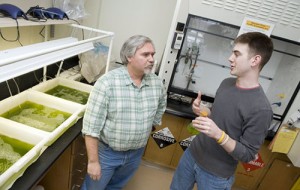A wastewater treatment plant might seem like the last place to find a fuel for the future, but a team of researchers has done just that.
Researchers at Rochester Institute of Technology are using algae grown in wastewater to produce biodiesel. They say the process is “doubly green” because the algae consume pathogens in the water even as they can be used to produce biofuel.
The process holds some appeal over conventional feedstocks like corn because algae is easy to grow, doesn’t require vast tracts of land to raise and uses photosynthesis to convert sunlight into energy.
“Algae—as a renewable feedstock—grow a lot quicker than crops of corn or soybeans,” researcher Eric Lannan said in a statement. “We can start a new batch of algae about every seven days. It’s a more continuous source that could offset 50 percent of our total gas use for equipment that uses diesel.”
Lannan and chemistry major Emily Young worked with Jeff Lodge, associate professor of biological sciences, to isolate and extract lipids from algae and produce biodiesel. They are growing Scenedesmus, a single-cell organism, using wastewater from a treatment plant in Irondequoit, New York.
[ad]
“Algae will take out all the ammonia [and] 88 percent of the nitrate and 99 percent of the phosphate from the wastewater — all those nutrients you worry about dumping into the receiving water,” Lodge said in a statement. “In three to five days, pathogens are gone. We’ve got data to show that the coliform counts are dramatically reduced below the level that’s allowed to go out into Lake Ontario.”
The team has increased its algae production from 30 gallons in the laboratory to 100 gallons in a tank at Environmental Energy Technologies, an RIT spinoff. This spring, the researchers plan to scale up production to as much as 1,000 gallons of wastewater. Northern Biodiesel will purify the lipids from the algae and convert them into biodiesel.


